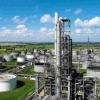Dear Sir
Could anyone kindly explain to me the rigorous Hysys method to calculate the latent heat of vaporization of mixture
posted on the following webiste.
http://webwormcpt.bl...nd-maximum.html
The step confusing me is following adapted from that website
STEP 2a : Determine liquid volume (Vl0) and vapor volume (Vv0) which will be defined by the physical vessel dimension and piping volume. Calculate liquid volume (Vl0) and vapor volume (Vv0) consider liquid level in the vessel is at maximum liquid level (L0) and piping vapor & liquid volume.
STEP 2b : Adjust the inventory (vapor mass and liquid mass) in the vessel until you achieve the vapor
volume (Vv0) and liquid volume (Vl0).
HYSYS : Copy stream 2 to stream 4. Copy stream 3 to stream 5. Mix stream 4 & 5 into stream 6. ADJUST stream 4 Mass Flow to obtain Stream 6 Vapor Actual Volumetric Flow to Vv0. ADJUST stream 5 Mass Flow to obtain Stream 6 Liquid Actual Volumetric Flow to Vl0.
STEP 3 : Bring the the system to Relieving pressure (Pr0=121% of Pset). By maintaining system volume at V0 (=Vv0+Vl0). The system is at relieving condition. The temperature at this point is Tr0.
HYSYS : Define a new stream 7 with a BALANCE unit (mole balance only). Set Stream 7 pressure at Pr0. ADJUST stream 7 temperature until Overall Actual Volumetric Flow to V0 (=Vv0+Vl0).
STEP 4 : Next step is further input heat (Q1) to achieve 1-2 deg C above Tr0 but maintain pressure at Pr0. Normally the total volume (V1) at this point potentially higher than V0.
HYSYS : Flash stream 7 in VESSEL V-101 into Vapor outlet, stream 6 and Liquid Outlet stream 11. Attach a heat stream (Q-100) into V-101. SET stream 8 temperature 1-2 degC above stream 7.
In Bechtel, the usual approach is to take the top tray liquid at relief pressure and estimate the enthalpy change required to flash increasing amount of vapor. If small amount water is present, the latent heat will drop off rapidly.
Could any expert kindly explain to me this calculation step of Latent Heat for multicomponent liquid mixture more physical intuitively ? Cause I don't see any step that flash out the water or other impurity. If you could provide me a solved example Aspen Plus file (.apw) or PRO \II for this multi-component mixture, I would greatly appreciated that.
My email : kanpe15@yahoo.com
Greatly appreciated any positive response.
Thanks you so much.
Regards,
|
|
Pls Help Estimating The Latent Heat Of Multi-Component Hydrocarbon Liq
Started by knapee, Feb 12 2012 01:14 AM
1 reply to this topic
Share this topic:
#1

Posted 12 February 2012 - 01:14 AM
#2

Posted 12 February 2012 - 03:10 AM
the basic procedure for simulating the discharging conditions under external fire has been discussed in several papers, I have a copy of a presentation at Chemputer's conference 1994 from Prode, if you are able to find a copy of Prode Calculator (the programmable process calculator discussed in the paper) it should include the code which you can then easily convert.
The basic is the direct integration method, you evaluate the properties of discharging fluid at the different conditions (as composition changes), you can put all in Excel and use a process library or a simulator for thermodynamics.
The basic is the direct integration method, you evaluate the properties of discharging fluid at the different conditions (as composition changes), you can put all in Excel and use a process library or a simulator for thermodynamics.
Attached Files
Edited by serra, 12 February 2012 - 03:11 AM.
Similar Topics
Steam Pressure In Heat ExchangerStarted by Guest_mvanrijnbach_* , 15 Apr 2025 |
|

|
||
Heat Exchanger Steam FlowStarted by Guest_aliebrahem17_* , 25 Nov 2024 |
|

|
||
Discussion - Predict Storage Tank Heat Transfer Precisely By Jimmy D KStarted by Guest_raj shekhar_* , 25 Mar 2025 |
|

|
||
Cross Over Temperature In Countercurrent Heat ExchangerStarted by Guest_panoska_* , 18 Feb 2025 |
|

|
||
Aspen Hysys - Blowdown Utility Heat Flux MethodStarted by Guest_yuvi.ardekar1999@gmail.com_* , 27 Feb 2025 |
|

|

 FB
FB







